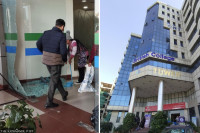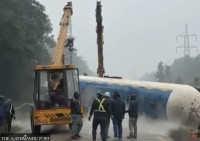National
Human trafficking still a major challenge for the country
Despite legal protections and law enforcing agencies in action, Nepali girls, women and children are still vulnerable to human trafficking.
Chandan Kumar Mandal
Six years ago, Sanju, then a tenth grader, fell in love with an army man in her hometown Itahari. They married two years later. Sanju was just 15 at the time, thus making their union illegal. After staying in Itahari for a month, the couple moved to Kathmandu.
Within a month of their arrival in Kathmandu, Sanju’s husband ran away, leaving her alone in their rented room.
“He went out of contact,” she told the Post on Wednesday. “There was hardly anyone whom I knew in Kathmandu. I could not go back home, as I had got married against my family’s wishes.”
The 21-year-old from Itahari spoke to the Post on the condition that she be identified by a pseudonym because she feared being ostracised by the family and the community.
Unable to pay monthly rent, the landlord threw away Sanju’s belongings. One day, a man approached her at a nearby eatery, whose owner allowed her to eat on credit.
“He told me that he knew everything about me and my life. And he offered me help get into some kind of business,” said Sanju. Unaware of consequences—and with no immediate help forthcoming—she fell for it. Sanju was thrown into the dark world of sex trade.
The deal was that the man would get 25 percent of her income from each client. Sanju agreed.
She was asked to create a fake account on Facebook through which he would connect her with new people. This went on for the next six months until she was finally picked up by a police team in Sundhara, where she was supposed to meet a client.
Sanju is one of the hundreds of human trafficking victims in the country who often fall into the trap of human trafficking.
“Many people ask me how can I be a victim of human trafficking since I was not trafficked to anywhere,” said Sanju, who is now doing her graduation in Kathmandu. “The law clearly states that if anyone takes advantage of someone’s condition, or uses any threat, influence, and lure them into doing sexual activities, it is also human trafficking.”
According to the Human Trafficking and Transportation (Control) Act, 2007, to use someone into prostitution, with or without any benefit, is also one form of human trafficking.
Sanju could get out of the nexus of human trafficking and start a new life after she came in touch with Shakti Samuha, a non-government organisation run by the survivors of human trafficking and working for the welfare of survivors and protection of those at risk. A large number girls and young women can never run out of the nexus.
In an annual gathering of human trafficking survivors held in Kathmandu on Wednesday, survivors, anti-human trafficking activists, political parties leaders, security forces agencies and others agreed that human trafficking continues to be a challenge for the country.
“Despite efforts at the national and international levels, women and children are at the risk of human trafficking,” said Anjana Shakya, chairperson of Alliance Against Trafficking In Woman And Children In Nepal. “There are regular reports of trafficking for sex trade and also via labour migration. Protection of those at risk, and rescue, rehabilitation and reintegration of survivors, which is the responsibility of the state, is still a big challenge.”
The US Department of State, in its ‘Trafficking in Persons Report 2019’, released in June placed Nepal in Tier 2. According to the report, the countries belonging to Tier 2 have governments that do not fully meet the minimum standards of the Trafficking Victims Protection Act. The law provides tools to combat trafficking in persons, both worldwide and domestically.
According to Shashi Shrestha, chairperson of State Affairs and Good Governance Committee of Parliament, the problem of human trafficking persists because the root cause of the problem is yet to be discovered.
“The country went through a massive political change, but the continuation of trafficking in person shows that political change alone cannot do much,” said Shrestha. “Discriminatory social structure that considers women as objects of use is the main cause. As long as this mentality remains, we cannot eliminate this problem.”
A recent report by the National Human Rights Commission says nearly 1.5million Nepalis are at risk of various forms of human trafficking.
According to the report, aspiring migrant workers, Nepalis working abroad, people in the entertainment sector, girls and women from rural areas, missing persons and child labourers are among the groups most vulnerable to trafficking, making the country a source, as well as a transit and destination for human trafficking. The report estimated that nearly 35,000 Nepalis were trafficked last year.
Niru Devi Pal, the chairperson of Women and Social Committee of Parliament, said the government should provide jobs to girls and women to protect them from potential trafficking.
Activists pointed out that human traffickers were getting political protection when existing laws fail to adequately protect human trafficking survivors and those at risk of trafficking.
“Human trafficking issue has not got the attention it deserves. Despite strong legal protection to protect women from all kinds of violence, they continue to be vulnerable,” said Tham Maya Thapa Magar, minister for women, children and senior citizens. “At times, culprits also get political protection. We need to boycott such persons from society. The government is committed to eliminating all forms of human trafficking.”
For law-enforcing agencies, human trafficking has turned even more complicated as it also takes place in the guise of labour migration, overseas jobs and studies, and traffickers adopt new tricks and technologies. The problem has gone beyond its fundamental purpose of sex trade and also gone far from India-Nepal cross border trafficking.
“These days, human trafficking is not limited to women and girls sold to brothels in India. Traffickers are taking advantage of people’s condition, poverty, illiteracy, among others,” said Sanju. “Traffickers and agents use social media, where everyone is these days. So, posting guards at the India-Nepal border doesn’t help entirely. We need to make people aware about online safety and how human trafficking takes place.”




 8.12°C Kathmandu
8.12°C Kathmandu













%20(1).jpg&w=300&height=200)

